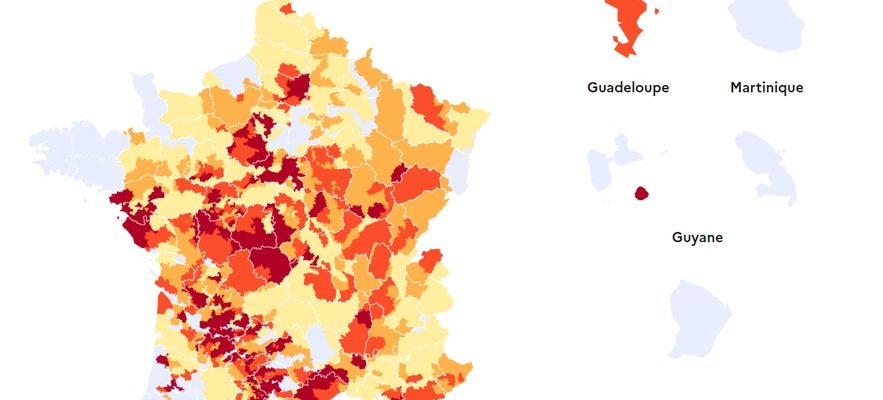The summer of 2023 has so far been marked by very wet weather over the northern half of the country, causing the surface drought to ebb in the country. But the summer rains are not enough to replenish the groundwater in depth and the situation remains highly contrasted depending on the region. The European drought indicator from the European Drought Observatory (EDO) takes into account precipitation, soil moisture and the state of vegetation depending on the region. But this indicator does not include groundwater levels, which remain at very worrying levels for the season. Across France, 72% of the groundwater levels remain below normal for the season on August 1, announced Thursday August 10 the Minister for Ecological Transition, Christophe Béchu – 4% more than in July.
A rainy summer that is not enough
That such a low level persists despite the significant rainfall in the summer of 2023 may come as a surprise. Indeed, the northern half of the country experienced significant rainfall for a summer season. In question, the unusual behavior of the polar jet-stream, an altitude current which normally officiates at the level of Scandinavia during the summer. It separates the cold zone from the temperate zone. While elsewhere in the world, the dislocation of this wind tube triggered unprecedented heat waves. Its migration towards the North of France, on the other hand, brought rains, winds and freshness. Good news, really?
Only in part. At the end of July, soil drought affected only 36.9% of European territory and the Mediterranean coasts – a proportion that is down sharply compared to the beginning of June (64.3%), explains the European Drought Observatory. In France, in the far west, in particular in Brittany and part of Aquitaine, the precipitation has made it possible to effectively combat the surface drought. But that is not enough to solve the problem.
Surface drought versus underground drought
France has just suffered several serious and consecutive periods of drought. First, the exceptional summer of 2022, with more than 1,200 rivers completely dry and 93 departments affected by water restrictions; then, this year, a major episode of winter drought. Between January and February 2023, it did not rain for 32 days in a row, during the natural period of groundwater recharge.
The persistence of these vulnerabilities in the spring has made summer rainfall insufficient in the early summer of 2023. The land hardened by consecutive droughts absorbs less and less water, and when summer comes, the heavy rains run off to the instead of penetrating the ground. In summer, the vegetation is also in full growth and it is this which will first capture the rainwater to maintain itself and develop. The mild summer temperatures also facilitate the evaporation of surface water. So many elements which explain the small quantity penetrating in depth, to the water tables, in spite of the abundant showers of July-August.
Several regions remain in crisis
The drought situation in France (Orders of August 11, 2023) – Map.
© / VigiEau (vigieau.gouv.fr)
“We are on data that is comparable to last year at the same time” but the situation is “very contrasting depending on the region”, insisted the Minister for Ecological Transition, Christophe Béchu. Indeed, if the Great West sees the situation improve thanks to the rains, 32 departments remain “in crisis” and 20 in “enhanced alert” throughout France. The Minister notably warned of “historically low levels on the […] of the Rhône and Saône valley”. In the Lyon region, for example, no improvement is expected in August, while the groundwater tables in mainland France currently remain in deficit by 23%. The drought alert has been generalized to the entire Rhône department since August 4. All so-called domestic and amenity uses (car washing, watering, filling swimming pools) are prohibited until the alert is lifted.
In Île-de-France, the phenomenon of drought persists everywhere, to varying degrees. At the end of July, half of the Yvelines department and the Orge area in Essonne had been placed on the threshold of “crisis”. In the Pays de la Loire, Mayenne is hit hard, the basins of Oudon and Sarthe downstream having been placed on “enhanced alert”. In Allier, in Auvergne Rhône-Alpes, the hydrological situation also continues to deteriorate for several basins. Even in Normandy, where rainfall was abundant, two new sectors passed the alert threshold on Thursday August 3.
In addition, water management has become more complicated since the beginning of August in the departments of Alpes-Maritimes, Dordogne, Doubs, Hérault, Pyrénées-Orientales, Var and Vosges. The Minister for the Ecological Transition announced that 85 municipalities were currently experiencing water shortages, that 67 of them were supplied by tanker trucks and 18 by the supply of bottled water. “A dozen (municipalities) more than a week ago,” lamented Christophe Béchu.
